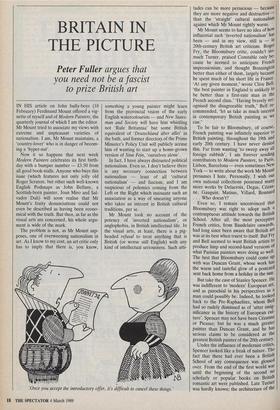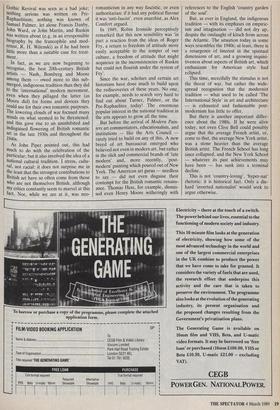BRITAIN IN THE PICTURE
you need not be a fascist to prize British art
IN HIS article on John bully-boys (18 February) Ferdinand Mount offered a vig- nette of myself and of Modern Painters, the quarterly journal of which I am the editor. Mr Mount tried to associate my views with extreme and unpleasant varieties of nationalism. I am, Mr Mount maintains, a `country-lover' who is in danger of becom- ing a 'hyper-nae.
Now it so happens that next week Modern Painters celebrates its first birth- day with a bumper number — £3.50 from all good book-stalls. Anyone who buys this issue (which features not only jolly old Roger Scruton, but other such well-known English Podsnaps as John Bellany, a Scottish-born painter, Joan Miro and Sal- vador Dali) will soon realise that Mr Mount's fruity denunciations could not even be described as having been econo- mical with the truth. But then, as far as the visual arts are concerned, his whole argu- ment is wide of the mark.
The problem is not, as Mr Mount sup- poses, one of overweening nationalism in art. As I know to my cost, an art critic only has to imply that there is, you know, something a young painter might learn from the provincial vision of the early English watercolourists — and New States- man and Society will have him whistling not 'Rule Britannia' but some British equivalent of 'Deutschland fiber alles' in the bath, and former directors of the Prime Minister's Policy Unit will publicly accuse him of wanting to start up a home-grown version of Sinn Fein, 'ourselves alone'.
In fact, I have always distrusted political nationalism. Even so, I don't believe there is any necessary connection between nationalism — least of all 'cultural nationalism' — and fascism; and I am suspicious of polemics coming from the Left or the Right which insinuate such an association as a way of smearing anyone who takes an interest in British cultural traditions, per se.
Mr Mount took no account of the potency of 'inverted nationalism', or anglophobia, in British intellectual life. In the visual arts, at least, there is a pig- headed refusal to treat anything that is British (or worse still English) with any kind of intellectual seriousness. Such atti- `Once you accept the introductory offer, it's difficult to cancel these things.' tudes can be more pernicious — because they are more negative and destructive than the 'straight' cultural nationalism against which Mr Mount rightly warns. Mr Mount seems to have no idea of how influential such 'inverted nationalism' has been — and in my view, still is — in 20th-century British art criticism. Roger Fry, the Bloomsbury critic, couldn't sto- mach Turner, praised Constable only be- cause he seemed to anticipate French impressionism, and thought Bonnington better than either of them, largely because he spent much of his short life in France. `At any given moment,' wrote Clive Bell, `the best painter in England is unlikely to be better than a first-rate man in the French second class.' Having bravely rec- ognised the disagreeable truth,' Bell re' commended, let us take as much interest in contemporary British painting as we can.'
To be fair to Bloomsbury, of course, French painting was infinitely superior to British painting, throughout the 19th and early 20th century. I have never denied this. Far from wanting 'to sweep away all foreign rubbish', I am forever sending contributors to Modern Painters, to Pans, Lisbon, Barcelona — even sometimes New York — to write about the work Mr Mount presumes I hate. Personally, I wish our own national collections possessed many more works by Delacroix, Degas, Cezan- ne, Gauguin, Matisse, Villard, Bonnard . . . Who doesn't?
Even so, I remain unconvinced that Bloomsbury was right to adopt such a contemptuous attitude towards the British School. After all, the most perceptive French critics, from Baudelaire onwards, had long since been aware that British art was at its best when truest to itself. But Fry and Bell seemed to want British artists to produce limp and second-hand versions of what Parisian painters were doing so well. Thebest that Bloomsbury could come UP with was Duncan Grant, whose work has the warm and tasteful glow of a postcard sent back home from a holiday in the sun- But take the case of Stanley Spencer. He was indifferent to 'modern' European art, and as parochial in his perspectives as a man could possibly be. Indeed, he looked back to the Pre-Raphaelites, whom Bell had so rudely dismissed as of 'utter insig- nificance in the history of European cul- ture'. Spencer may not have been Cezanne or Picasso; but he was a much greater painter than Duncan Grant, and he has serious claims to be considered as the greatest British painter of the 20th century.
Under the influence of modernist critics, Spencer looked like a freak of nature. The fact that there had ever been a British School of any consequence was glossed over. From the end of the first world war until the beginning of the second no scholarly or popular books on British romantic art were published. Late Turner was hardly known; the architecture of the
Gothic Revival was seen as a bad joke; nothing serious was written on Pre- Raphaelitism; nothing was known of Samuel Palmer, let alone Francis Danby, John Ward, or John Martin, and Ruskin was written about (e.g. in an irresponsible biography by the francophile and mod- ernist, R. H. Wilenski) as if he had been little more than a suitable case for treat- ment.
In fact, as we are now beginning to recognise, the best 20th-century British artists — Nash, Bomberg and Moore among them — owed more to this sub- merged, indigenous tradition than they did to the 'international' modern movement, even when they pillaged the latter (as Moore did) for forms and devices they Could use for their own romantic purposes. The lowering clouds of war focused many minds on what seemed to he threatened: and this gave rise to an uninhibited and indisguised flowering of British romantic art in the late 1930s and throughout the 1940s.
As John Piper pointed out, this had much to do with the celebration of the particular; but it also involved the idea of a national cultural tradition. I stress, cultu- ral, not racial: it does not surprise me in the least that the strongest contributions to British art have so often come from those who are not themselves British, although my critics constantly seem to marvel at this fact. Nor, while we are at it, was neo-
romanticism in any way fascistic, or even authoritarian: if it had any political flavour it was 'anti-fascist', even anarchist, as Alex Comfort argued.
In 1949, Robin Ironside perceptively remarked that this new sensibility was 'in part a reaction from the ideas of Roger Fry, a return to freedom of attitude more easily acceptable to the temper of our culture, a freedom of attitude that might acquiesce in the inconsistencies of Ruskin but could not flourish under the system of Fry'. Since the war, scholars and certain art historians have done much to build upon the rediscoveries of these years. No one, for example, needs to search very hard to find out about Turner, Palmer, or the Pre-Raphaelites today! The enormous popular interest in the national tradition in the arts appears to grow all the time.
But before the arrival of Modern Pain- ters art commentators, educationalists, and institutions — like the Arts Council rarely tried to build on any of this. A new breed of art bureaucrat emerged who believed not even in modern art, but rather in the slick and commercial brands of 'late modern' and, more recently, 'post- modern' painting which poured out of New York. The American art gurus — needless to say — did not even disguise their contempt for the British romantic renaiss- ance. Thomas Hess, for example, dismis- sed even Henry Moore witheringly with
references to the English 'country garden of the soul'.
But, as ever in England, the indigenous tradition — with its emphases on empiric- ism and imagination — did not dry up, despite the onslaught of kitsch from across the Atlantic. The situation today in some ways resembles the 1940s: at least, there is a resurgence of interest in the spiritual dimensions of art, and a growing inquisi- tiveness about aspects of British art, which enthusiasm for American style had eclipsed.
This time, mercifully the stimulus is not the threat of war, but rather the wide- spread recognition that the modernist tradition — what used to be called 'The International Style' in art and architecture — is exhausted and fashionable post- modernism has little to offer.
But there is another important differ- ence about the 1980s. If he were alive today, not even Clive Bell could possibly argue that the average French artist, or, come to that, the average New York artist, was a stone heavier than the average British artist. The French School has long since collapsed, and the New York School — whatever its past achievements may have been — has sunk into a terminal decline.
This is not 'country-loving', 'hyper-nat' rhetoric: it is historical fact. Only a die- hard 'inverted nationalist' would seek to argue otherwise.

















































 Previous page
Previous page